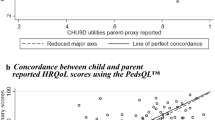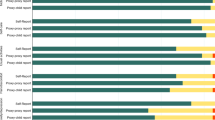Abstract
Purpose
To examine parent–child agreement regarding a child’s health-related quality of life (HRQOL) among three health status groups.
Methods
Parent–child agreement was evaluated for three health status groups of a population-based sample: (1) children with mental health problems (N = 461), (2) children with physical health problems (N = 281), and (3) healthy controls (N = 699). The KIDSCREEN-27 was used to assess HRQOL. The children were 9–14 years of age.
Results
Intraclass correlation coefficients were mostly good across all HRQOL scores and health status groups. This relatively high level of agreement was also reflected by the following findings: first, the AGREE group was the largest in three out of five HRQOL subscales in all health status groups; second, when disagreement occurred, it was often minor in magnitude. Despite this relatively high level of agreement, the means of self-ratings were significantly higher for all HRQOL scores and health status groups than the means of proxy ratings. These higher self-ratings were especially pronounced among children with mental health problems in certain HRQOL domains.
Conclusions
Even though the level of parent–child agreement regarding a child’s HRQOL is relatively high, it should be considered that children (especially those with mental health problems) often report better HRQOL than their parents. It is, therefore, highly recommended that both proxy- and self-ratings are used to evaluate a child’s HRQOL comprehensively.


Similar content being viewed by others
References
Achenbach TM, McConaughy SH, Howell CT (1987) Child/adolescent behavioral and emotional problems: implications of cross-informant correlations for situational specificity. Psychol Bull 101(2):213–232
Mesman J, Koot HM (2000) Child-reported depression and anxiety in preadolescence: I. Associations with parent- and teacher-reported problems. J Am Acad Child Adolesc Psychiatry 39(11):1371–1378. doi:10.1097/00004583-200011000-00011
Salbach-Andrae H, Lenz K, Lehmkuhl U (2009) Patterns of agreement among parent, teacher and youth ratings in a referred sample. Eur Psychiatry 24(5):345–351. doi:10.1016/j.eurpsy.2008.07.008
Woo BS, Ng TP, Fung DS, Chan YH, Lee YP, Koh JB, Cai Y (2007) Emotional and behavioural problems in Singaporean children based on parent, teacher and child reports. Singapore Med J 48(12):1100–1106
Taylor RM, Gibson F, Franck LS (2008) A concept analysis of health-related quality of life in young people with chronic illness. J Clin Nurs 17(14):1823–1833. doi:10.1111/j.1365-2702.2008.02379.x
Matza LS, Swensen AR, Flood EM, Secnik K, Leidy NK (2004) Assessment of health-related quality of life in children: a review of conceptual, methodological, and regulatory issues. Value Health 7(1):79–92. doi:10.1111/j.15241524-4733,2004.71273.x
Coghill D, Danckaerts M, Sonuga-Barke E, Sergeant J (2009) Practitioner review: quality of life in child mental health-conceptual challenges and practical choices. J Child Psychol Psychiatry 50(5):544–561. doi:10.1111/j.1469-7610.2009.02008.x
Eiser C, Morse R (2001) A review of measures of quality of life for children with chronic illness. Arch Dis Child 84(3):205–211
Wallander JL, Schmitt M, Koot HM (2001) Quality of life measurement in children and adolescents: issues, instruments, and applications. J Clin Psychol 57(4):571–585
Eiser C, Morse R (2001) Can parents rate their child’s health-related quality of life? Results of a systematic review. Qual Life Res 10(4):347–357
Upton P, Lawford J, Eiser C (2008) Parent–child agreement across child health-related quality of life instruments: a review of the literature. Qual Life Res 17(6):895–913. doi:10.1007/s11136-008-9350-5
McGraw KO, Wong SP (1996) Forming inferences about some intraclass correlation coefficients. Psychol Methods 1(1):30–46
Sattoe JN, van Staa A, Moll HA, Feet RGOYO (2010) The proxy problem anatomized: child–parent disagreement in health related quality of life reports of chronically ill adolescents. Health Qual Life Outcomes 2012 10(10): 1–13
Klassen AF, Miller A, Fine S (2004) Health-related quality of life in children and adolescents who have a diagnosis of attention-deficit/hyperactivity disorder. Pediatrics 114(5):e541–e547. doi:10.1542/peds.2004-0844
Limbers CA, Ripperger-Suhler J, Heffer RW, Varni JW (2011) Patient-reported Pediatric Quality of Life Inventory 4.0 Generic Core Scales in pediatric patients with attention-deficit/hyperactivity disorder and comorbid psychiatric disorders: feasibility, reliability, and validity. Value Health 14(4):521–530. doi:S1098-3015(10)00038-0
Escobar R, Soutullo CA, Hervas A, Gastaminza X, Polavieja P, Gilaberte I (2005) Worse quality of life for children with newly diagnosed attention-deficit/hyperactivity disorder, compared with asthmatic and healthy children. Pediatrics 116(3):e364–e369. doi:10.1542/peds.2005-0386
Varni JW, Burwinkle TM (2006) The PedsQL as a patient-reported outcome in children and adolescents with attention-deficit/hyperactivity disorder: a population-based study. Health Qual Life Outcomes 4:26–36. doi:10.1186/1477-7525-4-26
Shipman DL, Sheldrick C, Perrin EC (2011) Quality of life in adolescents with autism spectrum disorders: reliability and validity of self-report. J Dev Behav Pediatr 32:85–89
Kiss E, Kapornai K, Baji I, Mayer L, Vetro A (2009) Assessing quality of life: mother–child agreement in depressed and non-depressed Hungarian. Eur Child Adolesc Psychiatry 18(5):265–273. doi:10.1007/s00787-008-0727-3
Lack CW, Storch EA, Keeley ML, Geffken GR, Ricketts ED, Murphy TK, Goodman WK (2009) Quality of life in children and adolescents with obsessive-compulsive disorder: base rates, parent–child agreement, and clinical correlates. Soc Psychiatry Psychiatr Epidemiol 44(11):935–942. doi:10.1007/s00127-009-0013-9
Rotsika V, Coccossis M, Vlassopoulos M, Papaeleftheriou E, Sakellariou K, Anagnostopoulos DC, Kokkevi A, Skevington S (2011) Does the subjective quality of life of children with specific learning disabilities (SpLD) agree with their parents’ proxy reports? Qual Life Res 20(8):1271–1278. doi:10.1007/s11136-011-9857-z
Bastiaansen D, Koot HM, Ferdinand RF, Verhulst FC (2004) Quality of life in children with psychiatric disorders: self-, parent, and clinician report. J Am Acad Child Adolesc Psychiatry 43(2):221–230. doi:00004583-200402000-00019
Mohler-Kuo M, Jann B, Dey M, Zellweger U (2011) A recruitment method to obtain community samples of children for survey research in Switzerland. Int J Public Health 56(3):353–356
Bethell CD, Read D, Stein REK, Blumberg SJ, Wells N, Newacheck PW (2002) Identifying children with special health care needs: development and evaluation of a short screening instrument. Ambul Pediatr 2(1):38–48
WHO (1992) The ICD-10 classification of mental and behavioural disorders. Clinical descriptions and diagnostic guidelines. WHO, Geneva
Mohler-Kuo M, Dey M (2011) A comparison of health-related quality of life between children with versus without special health care needs, and children requiring versus not requiring psychiatric services. Quality Life Res. doi:10.1007/s11136-011-0078-2 [Epub ahead of print]
The KIDSCREEN Group (2006) The Kidscreen questionnaires. Quality of life questionnaires for children and adolescents. Pabst Science Publishers, Lengerich
Cronbach LJ (1951) Coefficient alpha and the internal structure of tests. Psychometrika 16(3):297–334
Nunnally JC, Bernstein IR (1994) Psychometric theory, 3rd edn. McGraw-Hill, New York
Landis JR, Koch GG (1977) The measurement of observer agreement for categorical data. Biometrics 33:159–174
Norman GR, Sloan JA, Wyrwich KW (2003) Interpretation of changes in health-related quality of life. The remarkable universality of half a standard deviation. Med Care 41(5):582–592
Sneeuw KCA, Sprangers MAG, Aaronson NK (2002) The role of health care providers and significant others in evaluating the quality of life of patients with chronic disease. J Clin Epidemiol 55(11):1130–1143
Danckaerts M, Sonuga-Barke EJ, Banaschewski T, Buitelaar J, Dopfner M, Hollis C, Santosh P, Rothenberger A, Sergeant J, Steinhausen HC, Taylor E, Zuddas A, Coghill D (2009) The quality of life of children with attention deficit/hyperactivity disorder: a systematic review. Eur Child Adolesc Psychiatry 19(2):83–105. doi:10.1007/s00787-009-0046-3
Katschnig H (2006) How useful is the concept of quality of life in psychiatry? In: Katschnig H, Freeman H, Sartorius N (eds) Quality of life in mental disorders. John Wiley, Chichester
Davis E, Nicolas C, Waters E, Cook K, Gibbs L, Gosch A, Ravens-Sieberer U (2007) Parent-proxy and child self-reported health-related quality of life: using qualitative methods to explain the discordance. Qual Life Res 16(5):863–871. doi:10.1007/S11136-007-9187-3
Biederman J, Newcorn J, Sprich S (1991) Comorbidity of attention-deficit hyperactivity disorder with conduct, depressive, anxiety, and other disorders. Am J Psychiatry 148(5):564–577
Acknowledgments
We thank all children and parents for their participation. Furthermore, we express our thanks to Fabian Dey for writing some of the data-cleaning programs; David Faeh, Yuri B. Suris, and Katharina Zogg Matt for helping us with the classification of CSHCN; and Alois Tschopp for his statistical consulting. This work was supported by the Swiss National Science Foundation (325130_125486) and the Swiss School of Public Health plus.
Conflict of interest
The authors declare that they have no conflicts of interest.
Author information
Authors and Affiliations
Corresponding author
Rights and permissions
About this article
Cite this article
Dey, M., Landolt, M.A. & Mohler-Kuo, M. Assessing parent–child agreement in health-related quality of life among three health status groups. Soc Psychiatry Psychiatr Epidemiol 48, 503–511 (2013). https://doi.org/10.1007/s00127-012-0556-z
Received:
Accepted:
Published:
Issue Date:
DOI: https://doi.org/10.1007/s00127-012-0556-z




